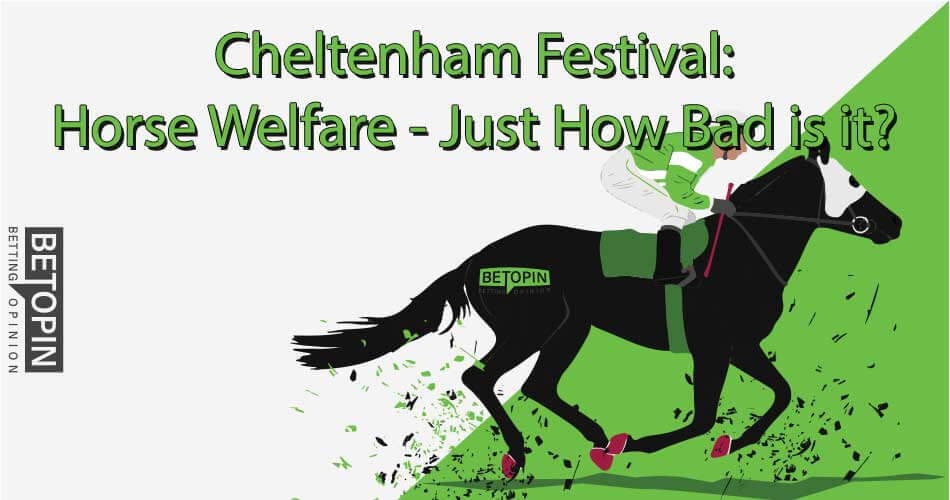Barbaric or Civilized – Is the Cheltenham Cup still Relevant or a Barbaric Remnant of a Bygone Era
Cheltenham Gold cup is a widely known horseracing event in the equestrian community that took place last month; however, the associated animal welfare concerns dampen the spirit of this festival. The historic importance of the Cheltenham festival is evident. Thousands of people participate every year to demonstrate their competitive skills and for recreation. Despite all of its social and economic importance, animal suffering and abuse could not be neglected.
According to horse racing regulatory boards, all necessary standards and procedures are provided to make sure the safety of horses and riders. A decrease in the fatalities of racehorses is also reported by regulatory authorities. Regardless of all these safety measures, incidents of fatal injuries are common. Episodes of horrifying behaviour towards horses by trainers and riders have also been provoked the animal welfare activists and way beyond. A common belief in animal welfare communities is that racing boards don’t show the actual picture of the damage done to the horses.
In this piece, we will attempt to answer the question of whether the Cheltenham Festival’s Gold Cup is barbaric or civilized. We will dig down to the details about the Cheltenham gold cup, the role of horseracing regulations, and associated animal welfare concerns.
Cheltenham Gold cup – A big day for horse racing
Cheltenham Gold Cup is the most prestigious national hunt horse race held every year at Cheltenham Festival in March. The First Cheltenham Gold cup was held in 1819 as a flat race. It was first run as a jump race in 1924 at the old course. In 1959 the venue of the gold cup was shifted to a new course which remained the same up till now.
At the new Cheltenham racecourse, horses have to race for 10 miles. The racecourse has 165 hurdles and 24 fences to make it more challenging. In a four-day long festival, races are held from Tuesday to Friday. The gold cup is the finale of the race and occurs on the Friday. Cheltenham Festival reported that 262,637 people attended the festival in 2018 with a crowd of 70,684 people at the gold cup. Total prize money for this year was £625 000 to be won in the Gold Cup.
With all the hustle of the festival, there is the dark side of the mistreatment of racehorses. They are forced and whipped to go beyond their natural capacity. There is a high chance of shattering their ankles, breaking their necks, and suffering from fatal injuries while jumping through dangerous fences. A racehorse suffers from a great many injuries and huge stress.
Sufferings of a racehorse
Horses are inclined to live in groups called herds. According to National Geographic, a horse herd consists of 3 to 20 horses. Most of the members are mares and their foals, lead by a stallion. Horses spend most of their time, grazing and walking. However, the life of a racehorse is quite different.
Before appearing in a race, a horse has to go through rigorous training, very little time to interact with fellow horses, physical and mental stress. A variety of feed supplements are used to develop the stamina and muscle of a horse. Although these management and feeding practices are adopted to increase the efficiency of a horse it takes a horse away from its natural lifestyle.
Equine Gastric Ulcers
A problem associated with racehorses is gastric ulcers. Céline Robert, in his book Equine Sports Medicine and Surgery, stated that a high prevalence of equine gastric ulcers is reported in performance horses including endurance horses. When a population of horses was examined for gastric ulcers at the end of 50km to 80km race, a high prevalence of 66.6% was found. Horses that are involved in long-distance races (90km to 160km) were found to have the prevalence of gastric ulcers up to 93%. Studies reported that the severity of lesions is directly related to the ride distance. And the prevalence of ulcers is significantly lower during inter-season as compared to the racing season.
The obvious reason for the correlation between gastric ulcers and racehorses is the low grazing time available to racehorses. The stomach of the horse keeps on secreting the acidic secretions, whether he has something to digest or not. Grazing at subsequent intervals of a day is necessary for a horse to maintain their gastric pH. Due to frequent training and travelling racehorses are more prone to gastric ulcers. According to Frank M. Andrews, training stress is also a leading cause of equine gastric ulcers. Excessive release of corticosteroids, in stressed horses, interacts with stomach protective factor (Prostaglandin) and tends to produce Ulcers.
Pulmonary hemorrhage In Racehorses
Exercise-induced pulmonary hemorrhage is another problem directly related to racehorses. The horses used to have strenuous activity for a short interval of time found with respiratory bleeding. It is also found that only 5% of horses with pulmonary hemorrhage bleed through the nose (epistaxis) and where it is easiest found. Using an endoscopic examination reveals the presence of blood in the tracheobronchial tree of 45% to 75% of horses. And the cytological examination of respiratory lavage identifies the hemorrhage in more than 90% of racehorses.
The proposed cause of pulmonary hemorrhage is increased pulmonary blood pressure. During vigorous exercise, blood pressure increases due to the thickening of pulmonary veins. When walls of pulmonary capillaries could not bear the pressure, they burst to lead to hemorrhage.
Gordon Elliot’s Moment of Madness
Besides the back-breaking training, sometimes horses become the victim of inhumane treatment by trainers and jockeys. The recent picture of Gordon Elliot astride a dead horse is the depiction of this harsh reality.
Gordon Elliot is a famous national hunt racehorse trainer. After working as an amateur jockey, he got the trainer’s license in 2006. He employed approximately 80 people and has 220 horses under his training and has been the closest rival to Willie Mullins to be the leading trainer in the competition in recent years.
The circulating picture on social media shows the trainer astride a dead horse with the gesture of triumph. After ending the speculations, Gordon Elliot revealed in an interview that it was a moment of madness. Such callous behaviour by an experienced person of the equine industry is horrifying. The horse was 7 years old Morgan which died due to a cardiac aneurysm during his gallop.
This picture of Gordon Elliot stirred up the concerns of the horseracing community and way beyond. On the verdict of the Irish Horseracing Regulatory Board (IHRB), Elliot has been banned from training for 12 months with the final 06 months of suspension. The investigation of IHRB and year-long punishment to Elliot is a good gesture but this stain on UK’s horseracing authorities cannot be revamped easily.
Another such cold-blooded incident of climbing over the back of a dead horse got its verdicts just days before the Cheltenham festival 2021. The accused is an amateur jockey – Robert James this time. Irish Horseracing Regulatory Authority investigated a video in which the jockey is climbing over the back of a dead horse. For damaging the proper conduct and good reputation of horse racing James got banned from riding for 12 months.
In response to Elliot’s scandal, British Horseracing Authority has recently issued a notification to open the doors of racing stables for public. So people can see that there is nothing to hide with respect to the racehorse welfare.
One death is too many!
Apart from ill-treatment with horses, there are alarming numbers of deaths associated with horse racing. And most of the animal welfare activists blame that facts and figures provided by horseracing authorities do not show the real picture. According to a horse deathwatch by Animal Aid, 186 horses were killed in 2019 as a direct result of racing. The 52 British racecourses have at least one incident.
It is not easy to find data about the causes of horse fatalities in race and training. However, there is an old but relevant study in Equine veterinary journal that provides data on causes of deaths in racehorses. The necropsies of 496 horses were performed at a California racetrack between 1990 and 1992 to categorize different causes of death in different breeds. Results of the study showed that most of the injuries occurred while racing (42%) and training sessions (39%). The most fractured bones in horses were proximal sesamoid bone, third metacarpal bones, and humerus. 90% of the limb fractures occurred in forelimbs.
At the Cheltenham Festival, incidents of horse deaths occur every year. According to Animal Aid, 68 causalities have occurred at the Cheltenham Festival since 2000 with a maximum of 11 deaths in 2005. Regulatory authorities claim the decrease in fatality rate as compared to last years.
Role of horseracing regulatory boards
On the other side, horseracing regulatory boards claim to develop and implement all necessary horse welfare rules. Members of the board device strategies for the welfare of horses and participants. Like British Horseracing Authority have clear rules and procedures for the welfare and health of horses and participants.
British Horseracing Authority
According to British Horseracing Authority, there is nothing more important to them than the safety of horses and jockeys. BHA has a developed an independently chaired horse welfare board for continuous improvement.
In February 2020 horse welfare board devised a 5-year strategic plan for horse welfare. It focuses on the traceability of horses bred for the race, their safety, and wellbeing, and on renewing their approach toward public communication. The horse welfare board is hopeful that this plan is a part of their continuous struggle for horse welfare. And the key outcomes of this plan will be in the form of increased safety and responsibility of horses. By using a proactive approach, horseracing will develop more trust of people in welfare authorities.
Currently, BHA plays its role in horse welfare by implementing these procedures.
- Birth: BHA requires registering the thoroughbred foals, who are intending to participate in the race, within 30 days of their birth. It helps the authority to trace any horse and make sure welfare standards are met.
- Trainer and Jockey: A candidate racehorse must be registered under a licensed trainer. British horseracing authority issued the licenses to trainers who met the high standards of horse welfare. BHA’s official personnel regularly inspect the training yards and condition of the horses. In the same way, only those jockeys got the license for riding who met the high standard set by BHA. Trainers and jockeys have to renew their license every year by giving an application and showing that they are meeting the BHA guidelines
- Racecourses: BHA has also provided regulations for racecourses. No course can be used for horseracing until it meets the animal welfare standards provided by authorities.
- Race Day: The manpower at race day used to increase many folds which include stewards, Veterinarians, Equine Welfare Integrity Officers (EWIO), Starters and judges. All these officials have a different set of responsibilities to observe equine welfare standards. One veterinary Officer and three veterinary surgeons are minimally required at a racecourse.
Along with all these facilities, BHA has developed a Center for Racehorse Studies. In this center, research is done on equine medicine which is used to provide international guidelines for equine medication.
Regardless of all the documented regulations and fascinating welfare boards, incidents of horse abuse are continuously happening. Many questions are still unanswered. Incidents of fatal injuries and on-spot euthanization have been seen by thousands of spectators.
With all provided facilities for horseracing, an average of 200 horses died every year on the British racetracks. When we explore the data of horse fatalities at Cheltenham Festival, it confirms that most of the horses died at an age less than 10 years. And the average life span of a horse ranges between 25 to 30 years. The efforts of the regulatory board for horse welfare could not be neglected. However, there is still a long way to go for equine welfare in horseracing. There is the need for independent horseracing Regulatory boards having the power to challenge the rules of the racing industry. It will not only be a great step toward horse welfare but will also help to diminish the concerns of people associated with horseracing.
Reference and further Readings
- https://www.cheltenhamfestival.net/guide/festival-facts/
- https://www.sciencedirect.com/science/article/pii/B9780702047718000521
- https://www.sciencedirect.com/science/article/pii/B9781455745555000649
- https://www.ihrb.ie/referrals-appeals/gordon-elliott-trainer-referral-5th-march-2021
- https://www.msdvetmanual.com/respiratory-system/respiratory-diseases-of-horses/exercise-induced-pulmonary-hemorrhage-in-horses
- https://beva.onlinelibrary.wiley.com/doi/abs/10.1111/j.2042-3306.1994.tb04395.x











